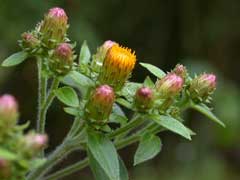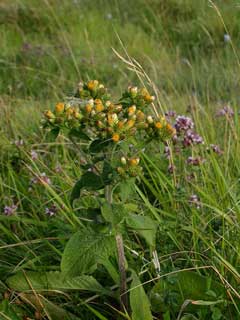 |
|
http://www.flickr.com/photos/84474308@N00/ |
 |
| http://www.flickr.com/photos/tico_bassie/ |
Translate this page:
Summary
Physical Characteristics

 Inula conyza is a BIENNIAL/PERENNIAL growing to 1.2 m (4ft) by 0.4 m (1ft 4in).
Inula conyza is a BIENNIAL/PERENNIAL growing to 1.2 m (4ft) by 0.4 m (1ft 4in).
See above for USDA hardiness. It is hardy to UK zone 6. It is in flower from July to August, and the seeds ripen from August to September. The species is hermaphrodite (has both male and female organs) and is pollinated by Bees, flies. The plant is self-fertile.
Suitable for: light (sandy), medium (loamy) and heavy (clay) soils and prefers well-drained soil. Suitable pH: mildly acid, neutral and basic (mildly alkaline) soils and can grow in very alkaline soils.
It cannot grow in the shade. It prefers moist soil.
UK Hardiness Map
US Hardiness Map
Synonyms
I. squarrosa. non L. Conyza squarrosa.
Plant Habitats
Woodland Garden Sunny Edge; East Wall. In. West Wall. In.
Edible Uses
References More on Edible Uses
Medicinal Uses
Plants For A Future can not take any responsibility for any adverse effects from the use of plants. Always seek advice from a professional before using a plant medicinally.
Antiscrophulatic Emmenagogue Parasiticide Vulnerary
The herb is antiscrofulatic, emmenagogue and vulnerary[4]. The plant was considered to be a good wound herb and it was frequently taken in decoction for bruises, ruptures, internal wounds etc[4]. It was applied externally to treat itchy skin[4].
References More on Medicinal Uses
The Bookshop: Edible Plant Books
Our Latest books on Perennial Plants For Food Forests and Permaculture Gardens in paperback or digital formats.

Edible Tropical Plants
Food Forest Plants for Hotter Conditions: 250+ Plants For Tropical Food Forests & Permaculture Gardens.
More

Edible Temperate Plants
Plants for Your Food Forest: 500 Plants for Temperate Food Forests & Permaculture Gardens.
More

More Books
PFAF have eight books available in paperback and digital formats. Browse the shop for more information.
Shop Now
Other Uses
Incense Insecticide Parasiticide
The leaves are burnt and used as an insecticide and parasiticide, especially against fleas[4, 100]. Even the smell of the plant is said to drive fleas away[4]. The root used to be burnt upon a fire in order to scent a room[245].
Special Uses
Scented Plants
References More on Other Uses
Cultivation details
Succeeds in an ordinary garden soil in a sunny position[1]. The basal leaves of this species are often mistaken for the foxglove, Digitalis purpurea[17]. The basal leaves form a rosette that covers the ground for 30cm or more, destroying the grass underneath[245]. All parts of the plant are refreshingly aromatic[245].
References Carbon Farming Information and Carbon Sequestration Information
Temperature Converter
Type a value in the Celsius field to convert the value to Fahrenheit:
Fahrenheit:
The PFAF Bookshop
Plants For A Future have a number of books available in paperback and digital form. Book titles include Edible Plants, Edible Perennials, Edible Trees,Edible Shrubs, Woodland Gardening, and Temperate Food Forest Plants. Our new book is Food Forest Plants For Hotter Conditions (Tropical and Sub-Tropical).
Shop Now
Plant Propagation
Seed - sow spring or autumn in a cold frame. When they are large enough to handle, prick the seedlings out into individual pots and plant them out in the summer. If you have sufficient seed, it is worthwhile trying a sowing in situ in the spring or the autumn.
Other Names
If available other names are mentioned here
Native Range
TEMPERATE ASIA: Cyprus, Iran (north), Lebanon, Syria, Turkey, Russian Federation-Ciscaucasia (Ciscaucasia), Armenia, Azerbaijan, Georgia, Russian Federation (Dagestan) EUROPE: Denmark, United Kingdom, Austria, Belgium, Switzerland, Czech Republic, Germany, Hungary, Netherlands, Poland, Slovakia, Moldova, Ukraine (incl. Krym), Albania, Bulgaria, Bosnia and Herzegovina, Greece, Croatia, Italy (incl. Sardinia, Sicily), North Macedonia, Montenegro, Romania, Serbia, Slovenia, Spain (incl. Baleares), France (incl. Corsica), Portugal AFRICA: Algeria
Weed Potential
Right plant wrong place. We are currently updating this section.
Please note that a plant may be invasive in one area but may not in your area so it's worth checking.
Conservation Status
IUCN Red List of Threatened Plants Status :

Growth: S = slow M = medium F = fast. Soil: L = light (sandy) M = medium H = heavy (clay). pH: A = acid N = neutral B = basic (alkaline). Shade: F = full shade S = semi-shade N = no shade. Moisture: D = dry M = Moist We = wet Wa = water.
Now available:
Food Forest Plants for Mediterranean Conditions
350+ Perennial Plants For Mediterranean and Drier Food Forests and Permaculture Gardens.
[Paperback and eBook]
This is the third in Plants For A Future's series of plant guides for food forests tailored to
specific climate zones. Following volumes on temperate and tropical ecosystems, this book focuses
on species suited to Mediterranean conditions—regions with hot, dry summers and cool, wet winters,
often facing the added challenge of climate change.
Read More
Expert comment
Author
DC.
Botanical References
17
Links / References
For a list of references used on this page please go here
Readers comment
© 2010, Plants For A Future. Plants For A Future is a charitable company limited by guarantee, registered in England and Wales. Charity No. 1057719, Company No. 3204567.